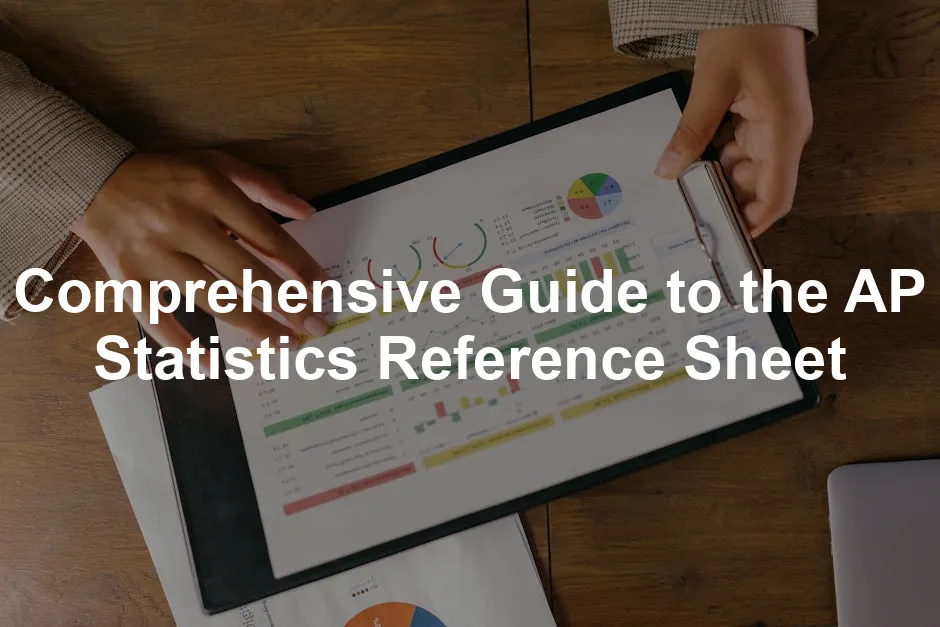Introduction
The AP Statistics exam is a rite of passage for many high schoolers. It’s more than just a test; it’s a gateway to college credits and a deeper understanding of data analysis. But let’s face it, the stakes can feel as high as a statistical outlier!
One key player in this exam drama is the AP Statistics reference sheet. This handy tool provides essential formulas and information that can save students from statistical despair. Why memorize endless equations when you can have them at your fingertips? The reference sheet is like a cheat code, allowing students to focus on problem-solving rather than struggling to remember formulas.
In this blog post, we’ll unpack everything you need to know about the AP Statistics reference sheet. We’ll discuss its structure, its significance, and how to make the most of it during the exam. Think of this as your trusty roadmap through the land of statistics, where the only thing you need to fear is miscalculating your caffeine intake during late-night study sessions.
Speaking of caffeine, why not keep your energy up with a Coffee Maker? It’s the perfect companion for those late-night study sessions, ensuring you stay alert and ready to tackle those tough statistics problems!
Ready to tackle this statistical adventure? Let’s dive right in!

Understanding the AP Statistics Reference Sheet
Overview of the AP Statistics Exam
The AP Statistics exam is structured into two main sections: multiple-choice and free-response. The multiple-choice section throws 40 questions at you, testing your knowledge and ability to apply statistical concepts. The free-response section includes 5 questions, requiring you to show your analytical prowess and demonstrate your understanding of the material.
Now, here’s where the reference sheet struts in, wearing its superhero cape. It’s printed at the front of both sections, ready to assist you whenever you need it. This two-sided sheet is packed with vital formulas, saving you from the mental gymnastics of memorization.
Importance of the Reference Sheet
Why is the reference sheet such a big deal? For starters, it’s a lifeline during the exam. It includes key formulas for descriptive statistics, probability, and inferential statistics. Not to mention, it helps streamline your exam strategy.
According to experts from Princeton Review and PrepScholar, the reference sheet is crucial for both test-taking and studying. It not only aids in boosting confidence on exam day but also serves as a study guide leading up to the test. Familiarizing yourself with the sheet can make it feel less daunting. It’s like having a cheat sheet that’s entirely legit!
So, as you prepare for the AP Statistics exam, remember: the reference sheet is more than just paper; it’s a powerful ally in your academic journey.

And what better way to organize your study materials than with a Desk Organizer? Keep your notes, highlighters, and snacks all in one place so you can focus on what really matters—acing that exam!
Detailed Breakdown of the AP Statistics Reference Sheet
Sections of the Reference Sheet
Descriptive Statistics
Descriptive statistics is the heart of data analysis. It’s all about summarizing and presenting data in a way that makes it easily digestible. The AP Statistics reference sheet includes key formulas that help you calculate various measures of central tendency and variability. Here’s a look at the most important ones.
Key Formulas:
- Mean (Average): The sum of all values divided by the number of values. It’s like the “popularity contest” of statistics—everyone wants to be average!
\[ \text{Mean} = \frac{\sum_{i=1}^{n} x_i}{n} \] - Median: The middle value in a data set when arranged in order. If there’s an even number of observations, it’s the average of the two middle numbers. Think of it as the “peacekeeper” of statistics—always in the center.
- Mode: The value that appears most frequently in a data set. It’s the “most popular kid in class.” A data set can have more than one mode, or none at all!
- Variance: This measures how far a set of numbers is spread out from their average value. It gives you a hint about the data’s consistency. The formula for variance is:
\[ \text{Variance} = \frac{\sum_{i=1}^{n} (x_i – \bar{x})^2}{n} \] - Standard Deviation: The square root of variance, it tells you how much individual data points deviate from the mean on average. A smaller standard deviation suggests that data points are closer to the mean.
\[ \text{Standard Deviation} = \sqrt{\text{Variance}} \]
Applications:
These statistics are applied in various fields, from business to healthcare. For instance, businesses use mean and standard deviation to analyze sales data, helping them understand performance trends. In healthcare, median values can present a clearer picture of patient outcomes, especially when dealing with skewed data distributions.
Visual aids like charts and graphs are invaluable in clearly presenting descriptive statistics. For example, a box plot can showcase the median and quartiles, while a histogram can display the distribution of data, highlighting the mode easily.

Imagine a histogram showing test scores in a class. You can quickly identify the most common score (mode), see how scores are spread out (variance), and find the average score (mean). These visuals can transform numbers into narratives that reveal trends at a glance.
Probability and Distributions
Probability is the backbone of statistics, helping us understand how likely events are to occur. It provides a framework for making informed decisions based on data. The reference sheet offers formulas that are crucial for calculating probabilities and understanding distributions.
Key Formulas:
- Addition Rule: Used to find the probability of either of two events occurring.
\[ P(A \cup B) = P(A) + P(B) – P(A \cap B) \] - Multiplication Rule: This calculates the probability of two independent events happening together.
\[ P(A \cap B) = P(A) \cdot P(B) \] - Binomial Distribution: Used when there are two possible outcomes (success or failure) in a fixed number of trials. The formula is:
\[ P(X = k) = \binom{n}{k} p^k (1-p)^{n-k} \] - Geometric Distribution: This applies to the number of trials until the first success occurs.
\[ P(X = k) = (1-p)^{k-1} p \]
Applications:
Probability plays a pivotal role in data interpretation and decision-making processes. For instance, in marketing, businesses might use probability to assess the likelihood of a consumer making a purchase based on past behavior.
Practical scenarios abound where probability shines. Consider a weather forecast predicting rain. The meteorologist uses historical data to calculate the probability of rain on a given day, helping you decide whether to carry an umbrella. Similarly, in quality control, manufacturers may apply binomial distribution to determine the probability of defective items in a production batch, guiding their quality assurance efforts.

Sampling Distributions and Inferential Statistics
Sampling distributions are the foundation of inferential statistics. They help us make educated guesses about population parameters based on sample statistics. The AP Statistics reference sheet provides essential formulas for this crucial area of study.
Key Formulas:
- Standard Error: This measures how much the sample mean is expected to vary from the true population mean. It’s calculated as:
\[ \text{Standard Error} = \frac{s}{\sqrt{n}} \] - Confidence Intervals: These are ranges around a sample statistic that likely contain the true population parameter. A common formula for a confidence interval for a mean is:
\[ \bar{x} \pm z\left(\frac{s}{\sqrt{n}}\right) \] - Chi-squared Tests: Used for testing relationships between categorical variables. The test statistic is calculated as:
\[ \chi^2 = \sum \frac{(O – E)^2}{E} \] where \(O\) is the observed frequency and \(E\) is the expected frequency.
Importance of Sampling:
Sampling distributions allow statisticians to estimate population parameters without surveying every individual. This is essential in research, where time and resources are often limited.
Case Studies:
Consider a clinical trial for a new medication. Researchers take a sample of patients to assess the drug’s effectiveness. By calculating the confidence interval for the treatment effect based on the sample, they can infer the likely effectiveness of the drug in the entire population.
Another example involves opinion polls during elections. Pollsters sample a small group of voters and use sampling distributions to estimate the candidate’s support level. This approach saves time and resources while providing valuable insights into public sentiment.
In conclusion, the AP Statistics reference sheet is a treasure trove of essential formulas and concepts. Understanding these sections—descriptive statistics, probability, and inferential statistics—is vital for mastering the exam and applying statistical knowledge in real-world situations. With a solid grasp of these elements, you’ll be ready to tackle any statistical challenge that comes your way!

Linear Regression and Correlation
Statistics can be as tangled as a ball of yarn, especially when you start talking about linear regression and correlation. But fear not! We’re here to unravel this knot with clarity and a dash of humor.
Key Formulas:
- Simple Linear Regression: The equation of a line is like the GPS of data. It helps predict outcomes based on input values. The formula is:
\[ y = mx + b \] where \(y\) is the predicted value, \(m\) is the slope, \(x\) is the independent variable, and \(b\) is the y-intercept. Imagine trying to predict how much coffee you need based on the hours of sleep you got—this formula is your trusty guide! - Correlation Coefficient (r): This nifty little number ranges from -1 to 1. It measures the strength and direction of a linear relationship between two variables.
\[ r = \frac{n(\sum xy) – (\sum x)(\sum y)}{\sqrt{[n \sum x^2 – (\sum x)^2][n \sum y^2 – (\sum y)^2]}} \] A value close to 1 means a strong positive correlation (think more sleep = more coffee consumed), while a value close to -1 indicates a strong negative correlation. Zero means no relationship—like your relationship with your alarm clock!
Interpreting Results:
Interpreting regression outputs can feel like reading tea leaves, but it doesn’t have to be mystifying. The slope \(m\) tells you how much \(y\) changes for every unit increase in \(x\). For example, if \(m = 2\), for every extra hour of sleep, your coffee intake increases by 2 cups.
The y-intercept \(b\) gives you the starting point when \(x = 0\). It’s like saying, “If I get zero sleep, I’ll still need a cup of coffee to start my day!”
The correlation coefficient \(r\) helps assess the relationship’s strength. A value above 0.8? Congratulations! You’ve got a strong link. Below 0.3? Well, that’s more like a casual acquaintance than a strong friendship.

Graphical Representations:
Visualizing data relationships is where the magic happens! Scatter plots are your new best friend. They plot individual data points on a graph, showing the relationship between two variables. Picture a scatter plot of students’ sleep versus their grades. You might see a trend where more sleep correlates with higher grades.
Adding a regression line to this scatter plot transforms it into a powerful storytelling tool. This line represents the best fit for your data points, helping predict future outcomes. If you see a diagonal line sloping upward, that’s a positive correlation! Conversely, a downward slope indicates a negative correlation.
In conclusion, linear regression and correlation are vital tools in your statistical toolkit. They help you understand relationships between variables and make predictions. By mastering these concepts, you’ll navigate the statistical landscape with confidence!
What’s Not Included on the Reference Sheet
While the AP Statistics reference sheet is a treasure trove of essential information, it doesn’t cover everything. Let’s talk about some important concepts that are missing but still crucial for your exam success.
Interquartile Range (IQR): The IQR measures the middle 50% of your data set. It’s calculated as:
\[
\text{IQR} = Q3 – Q1
\]
This value helps identify outliers. If a data point lies more than 1.5 times the IQR above Q3 or below Q1, it’s considered an outlier. Understanding the IQR is essential for grasping data distribution.
Bayes’ Theorem: This powerful theorem calculates conditional probabilities, allowing you to update the probability of an event based on new information. The formula is:
\[
P(A|B) = \frac{P(B|A) \cdot P(A)}{P(B)}
\]
Although it’s not on the reference sheet, it’s invaluable for making informed decisions based on prior knowledge.
Residuals in Regression Analysis: Residuals are the differences between observed values and predicted values. The formula is:
\[
e = y – \hat{y}
\]
where \(e\) is the residual, \(y\) is the observed value, and \(\hat{y}\) is the predicted value. Understanding residuals helps you assess the accuracy of your regression model. If residuals are randomly scattered around zero, your model is likely a good fit.
These concepts may not be on the reference sheet, but they’re essential for your understanding of statistics. They provide depth to your knowledge and prepare you for various exam scenarios. So, while you may not find them on the sheet, be sure to study them thoroughly!
Study Tips for Maximizing the Use of the Reference Sheet
Familiarization with the Sheet
First things first, get to know your reference sheet! It’s like meeting your favorite celebrity—you want to remember every detail. Spend time familiarizing yourself with its layout and contents. Understand where each formula and key concept is located.
Here’s a fun strategy: create a mini map of the sheet. Draw it out and label sections. This way, you can visualize where to find specific formulas during the exam. When panic hits, you’ll know exactly where to look instead of frantically searching.
Practice using the reference sheet in mock exams. It’s like training for a big marathon; you wouldn’t run the race without practice! Get comfortable with the sheet so you can quickly locate what you need when the clock is ticking.

And let’s not forget about the importance of staying hydrated! Keep a Water Bottle with Time Markers handy to track your hydration throughout your study sessions. Staying hydrated is key to keeping your brain sharp!
Practice with the Reference Sheet
Practice makes perfect! Take full-length practice exams while using the reference sheet. This not only helps you become accustomed to its layout but also allows you to test your knowledge of how to apply the formulas.
Check out resources like the College Board’s official practice tests. Websites like Princeton Review and PrepScholar also offer practice questions specifically designed for the AP Statistics exam. Use these to simulate exam conditions!
Additionally, don’t just skim through the practice questions—actually work through them, formulas in hand. It’s a great way to reinforce your understanding and application of statistical concepts. The more you practice, the more confident you’ll feel on test day.
Additional Study Resources
Want to up your study game? There are a plethora of resources available to help you ace AP Statistics. First, consider online courses. Websites like Khan Academy and Coursera offer fantastic statistics courses that can deepen your understanding.
For those who prefer a social aspect, look for study groups in your school or online forums. Reddit’s AP Statistics community is a goldmine for discussing concepts and clarifying doubts. You can share tips, resources, and even make study buddies!
Lastly, don’t forget about tutoring options. If you’re struggling with specific topics, a tutor can provide personalized guidance and support. Websites like Wiingy offer online tutoring specifically for AP Statistics.
Armed with these strategies and resources, you’ll be ready to tackle the AP Statistics exam with confidence. Remember, the reference sheet is not just a crutch; it’s your ally in statistical success!

Conclusion
The AP Statistics reference sheet is like your secret weapon for exam success. This handy tool holds the key to essential formulas that can save you precious time during the test. Forget about cramming endless equations into your brain; the reference sheet is right there to support you. It’s printed at the front of both the multiple-choice and free-response sections, making it easily accessible when you need it the most.
Why is this so important? Well, familiarity with the reference sheet can boost your confidence. Knowing where everything is located allows you to focus on solving problems, rather than wrestling with your memory. According to experts from Princeton Review and PrepScholar, the sheet not only aids in test-taking but also serves as a valuable study guide.
As you integrate these insights into your study plans, practice using the reference sheet during mock exams. The more you familiarize yourself with it, the less intimidating it will feel on the big day. Remember, it’s not just a sheet of paper; it’s a map guiding you through the tricky terrain of statistics!
So, as you gear up for the AP Statistics exam, keep this in mind: preparation is key. Embrace the reference sheet as your trusty sidekick. With the right mindset and tools, you can conquer the exam with ease. Ready to crush those statistics? Let’s do this!
FAQs
Common Questions
- What is included in the AP Statistics reference sheet?
The AP Statistics reference sheet includes crucial formulas divided into three main sections. You’ll find formulas for descriptive statistics, such as mean, median, and standard deviation. Probability and distributions are covered too, featuring the binomial and geometric distributions. Lastly, inferential statistics have their own section, detailing confidence intervals and standardized test statistics. It’s a comprehensive guide that streamlines your exam experience. - How can I best utilize the reference sheet during the exam?
To make the most of the reference sheet, familiarize yourself with its layout beforehand. Practice using it while taking mock exams. This approach will help you remember where each formula is located. During the actual exam, don’t hesitate to glance at the sheet for formulas you’re unsure about. Remember, it’s there to assist you, so use it wisely! - What should I study that is not on the reference sheet?
Despite its helpfulness, some important concepts aren’t included on the reference sheet. Focus on understanding the interquartile range (IQR), Bayes’ Theorem, and residuals in regression analysis. These concepts are essential for exam questions and will enhance your overall statistical knowledge. - Are there any practice resources available?
Absolutely! Websites like Khan Academy and College Board offer excellent practice resources tailored for AP Statistics. Additionally, consider using PrepScholar and Princeton Review for practice tests. These platforms provide sample questions and full-length practice exams that will help you get comfortable with the exam format. - How does the reference sheet affect my study strategy?
Understanding the reference sheet can shape your study habits significantly. Knowing what’s included allows you to focus on mastering the concepts that are not present. It also encourages efficient studying, as you won’t waste time memorizing formulas you can have on test day. Utilize the reference sheet as a guide to identify your weak areas and strengthen your grasp on those topics.
We hope this guide answers your questions about the AP Statistics reference sheet! If you have more inquiries or want to share your experiences, feel free to drop a comment below. Your insights could help fellow students on their road to success!
Please let us know what you think about our content by leaving a comment down below!
Thank you for reading till here 🙂
All images from Pexels




